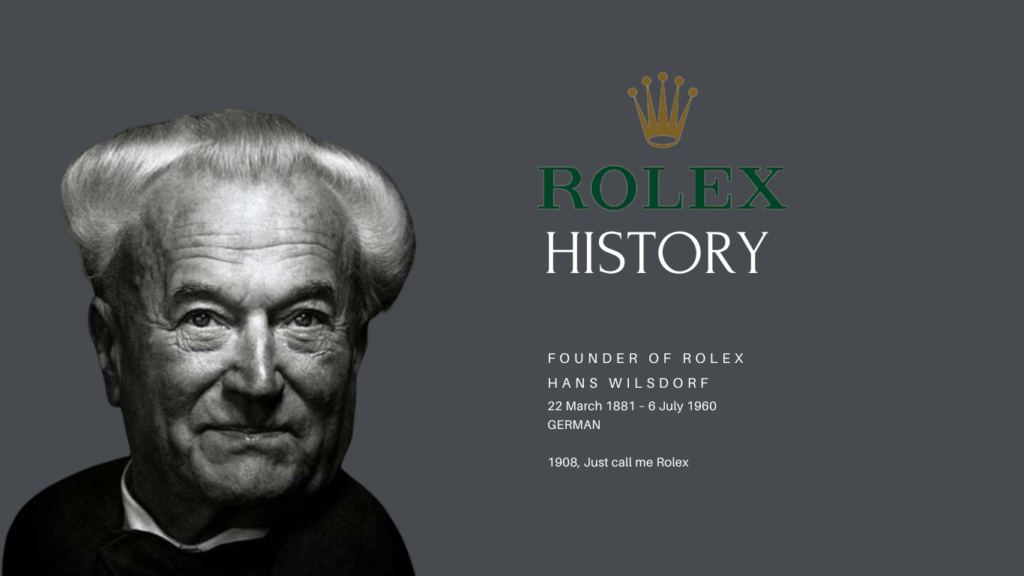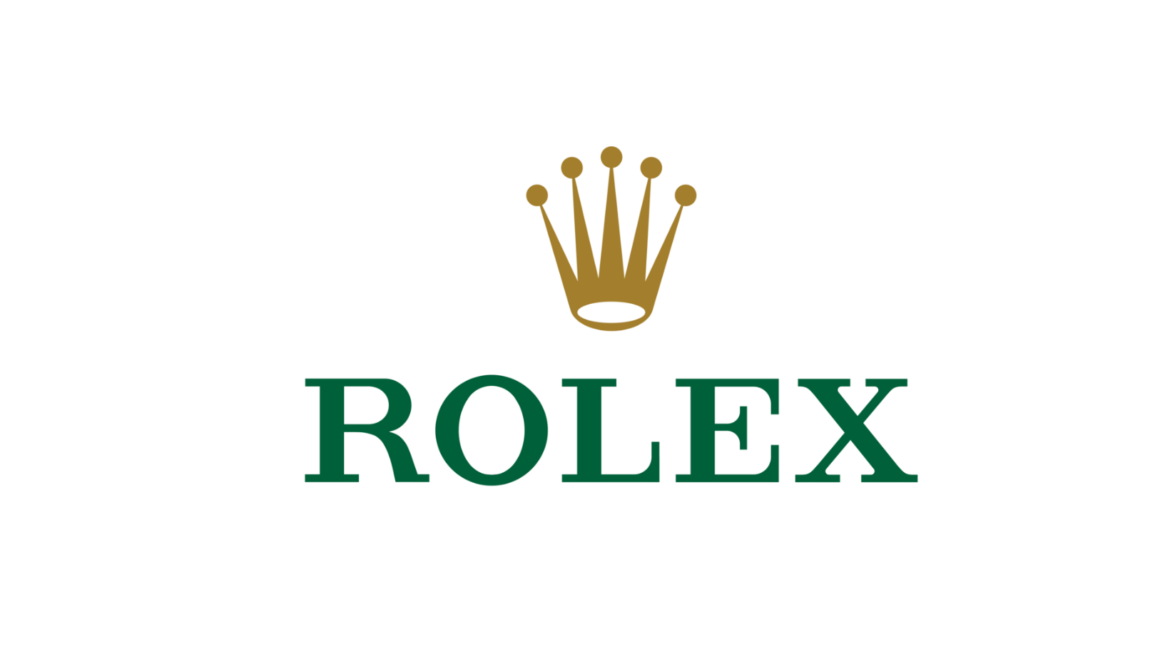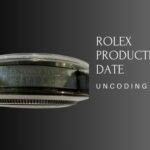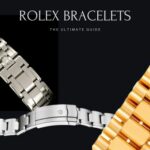ROLEX FOUNDER
Rolex was and still is a vision that came into life due to the one and only Hans Wilsdorf. Becoming one of the most iconic and well known brands in the watch industry, synonyms to power, wealth and style. With many celebrities as loyal customers it has managed to become a status symbol for all, in the recent years due to the high demand the prices have gone insane, creating a new era among watch collectors.

1881 Germany, Hans Wilsdorf
On 22 March of 1881 Hans Wilsdorf the founder of Rolex was born in Bavaria Germany.
1900 Neuchatel, Switzerland
Hans Wilsdorf moved to Neuchatel in Switzerland in order to work as a clock expert for La Chaux de Fonds. Neuchatel was and still is a small town well known in the watch industry.
1903 London, United Kingdom
In 1903 Hans Wilsdorf moved to London and the journey for Rolex beggins.
1905 London, Hans Wilsdorf and Alfred Davis
The 24 year old Hans Wilsdorf along with his business partner Alfred Davis founded Rolex . Initially, the company was known as “Wilsdorf and Davis” and its main activity was importing Swiss watch movements and dials and placing them in high-quality watch cases.
1907, Back to Chaux-de-Fonds in Switzerland
“Wilsdorf and Davis” are opening an office in La Chaux-de-Fonds, Switzerland almost 7 years after he left Switzerland Wilsdorf is returning back to his roots in watch industry where everything started.
1908, Just call me Rolex
The origin of the name is somewhat mysterious, but the rumours are that “Rolex” was chosen because it was short, easy to pronounce in any language, and could fit well on a watch dial. Wilsdorf believed that a watch should be reliable, precise, and elegant, and he wanted the brand name to reflect these qualities.
1910, Swiss Certificate of Chronometric Precision
As the quality was in the top rank of the hierarchy, all its effort was focused on the quality of the movement. In 1910, Rolex became the first wristwatch to receive the Swiss Certificate of Chronometric Precision, granted by the Horology Society in Bienne. This certification marked the beginning of Rolex’s reputation for precision and accuracy.
1912, Rolex Watch Co in Vienna
Two years after the award Rolex began manufacturing watches in Bienne Switzerland creating more connections with Switzerland.
1916, Bienne is where the magic happens
As in 1912 Rolex decided to manufacture watches in Bienne in 1916 they strategically decided to also move their technical office from La Chaux de Fonds to Bienne in order to ensure that their operations will work smoothly. Having both teams under the same roof ensured the level of quality and excellence that they committed too.
1919, Swiss Headquarters and Manufacturing
As Davis is no longer involved in the company Wilsdorf decided to live in Switzerland and following that Rolex moved its headquarters and manufacturing to Geneva, the mecca of the watch industry. This move marked the company’s transition into a fully-fledged Swiss watch manufacturer.
1925, Crown
Rolex crown logo is officially registered as a trademark.
1926, Oyster Case
In 1926, Rolex patented the screw down crown and therefore managed to introduce the world’s first waterproof and dustproof wristwatch, known as the “Rolex Oyster”. It is taking its name due to its extra protective case just like a mollusk shell. This innovation revolutionized the watch industry cause as it was extremely sealed and protected, it made wristwatches more durable and reliable.
1929, Prince Watch
In 1929 Prince watch was presented, including models 971, 971 A and 971 U, one of the most popular watches among the watch collectors.
1931, Perpetual Rotor
In 1931, Rolex patented the “Perpetual” , an automatic rotary winding mechanism, that allowed the watch to be wound by the motion of the wearer’s arm. This revolutionary invention eliminated the need for manual winding and set a standard for automatic movements in wristwatches that has set a new era in the watch industry. This was a breakthrough as now the second main category is added in the watch history dividing them into manual winding and automatic. In the next decades a new category will be added, quartz watches.
1935, Kings George V Limited Order
Five hundred Rolex Prince watches were ordered from King George V in order to be given as a gift at the special event organized to celebrate the King’s Silver Jubilee.
1937, Precision and Oyster Zeographs
In 1937 Precision was introduced to the public with two models 3642 and 3346. In the same year the first Oyster Zerograph was also released with 3642 and 3346 models that included a calibrated bezel that surrounded the watch and was later used in many sports models in the 1960s.
1941, Bubble Back Oyster and Oyster Perpetual
A new balance mechanism was introduced also known to the public as Superbalance, developed for the Oyster and Oyster Perpetual “bubble back” models. They were called Bubble Back because in order for the bigger mechanism to be included they had to create a bigger case back that looked like a bubble.
1945, Datejust
1945 the year that Datejust was born, the first automatic waterproof chronometer with indication of date in the window of the dial accompanied with a Jubilee bracelet. In the years to come many new models were introduced to the public, creating Datejust one of the most well series of Rolex and the pillar in its Oyster Perpetual Collection.
1952, Explorer
Rolex Explorer was launched through model 6098, designed for adventurers and mountaineers. The following year in May 1953 Explorer was given to members of Sir John Hunt’s expedition to Mount Everest.
1953, the year of Deep Sea, Turn -O- Graph and Submariner
1953 was probably one of the most important years in the history of Rolex as three of the most iconic watch models were introduced. The Rolex Explorer, designed for adventurers and mountaineers launched in 1952 but officially presented in 1953. Rolex Submariner, designed for divers and officially launched in 1954. And last but not least,Turn-O- Graph model 6202 that was available in steel and gold steel. These models remain popular and respected to this day.
1954, Milgauss
Milgauss, synonymous with the watch for scientists with its magnetic field, introduced its first model 6541.
1955, GMT-Master
In 1955 the Rolex GMT-Master 6542 was launched as a result of the collaboration with Pan American World Airways (Pan Am) that wanted to design a watch for their pilots special needs when traveling to different time zones. It featured a fourth hand that displayed a second time zone, making it ideal for international travellers in order to keep track with the time changes. GMT Master was a true revolution to the global community of watch fanatics.
1956, Day Date
Almost 11 years after the launch of Rolex DateJust, Rolex introduced the amazing Day Date. A watch that you could easily spot the day and the date on the dial.
Mid 1960
Rolex founder Hans Wilsdorf died in Geneva.
1960, Cosmograph
In 1960 the first Cosmograph chronograph with reference 6239 was launched, featuring a tachymetric timing ring on the metal bezel. Months later 6241 is following but with an acrylic bezel.
1963, Daytona
The historic Rolex Daytona was named after the Daytona racing track , originally designed for racing drivers, gained immense popularity and is highly sought after by collectors. It took its name from Daytona beach, one of the most iconic racing spots. Daytona features a tachymeter scale and chronograph functions.
1966, Comex
In 1966 Rolex started working on an amazing new project with the diving company COMEX (Compagnie Maritime d’ Expertise). Comex divers needed an advanced watch as they used to spend long hours in pressuring champers breathing helium and oxygen gasses. During this time the helium molecules were able to penetrate the watch. At the end of this procedure the divers were brought back to the atmospheric pressure creating a built up pressure inside the watch that had as a result the crystal to be pushed out of the watch creating damage to the watch. In order to solve this problem Rolex fitted an ingenious gas escape valve in the Submariner Sea- Dweller 2000.
1970, The War of Quartz
Rolex weathered the “Quartz Crisis” in the 1970s when the watch industry was threatened by the rise of quartz movement watches (that use batteries). In these really tough market changes Rolex managed to focus on its original commitment to provide to its customers traditional mechanical movements and maintained its commitment to quality.
1971, Explorer II
The Explorer II model 1655 is launched.
Rolex has continued to innovate with various features and materials, including the use of Cerachrom ceramic bezels and Paraflex shock absorbers. The brand is known for its exceptional craftsmanship, precision, and robustness.
Today, Rolex is synonymous with luxury, quality, and prestige in the watch industry. Its watches are worn by a diverse range of people, from world leaders and celebrities to adventurers and professionals. Rolex’s commitment to innovation and timeless design has solidified its place as one of the most prestigious watchmakers in the world.



